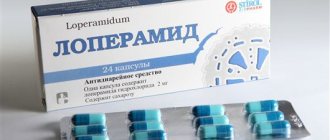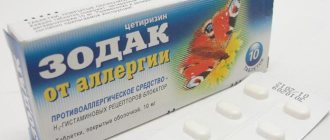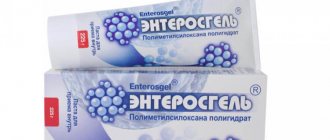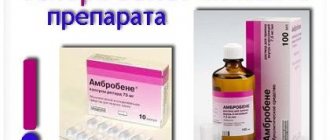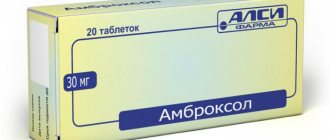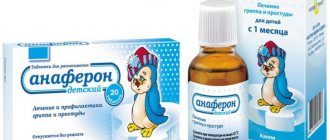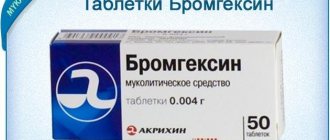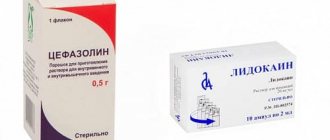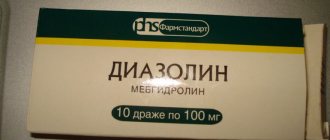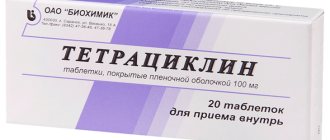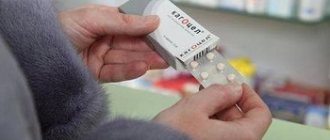An allergic reaction can cause a lot of problems for a baby, especially when it comes to constant itching and rashes - it’s impossible to explain to a baby that scratching his skin only makes things worse. There are many reasons for allergies: poor nutrition of the mother during pregnancy and lactation, low-quality artificial milk formula, heredity. In the latter case, the presence of allergies in one of the parents significantly increases the risk of a similar problem in the child. Animal fur, clothing, plant pollen, detergents and other factors can also cause allergies. Loratadine is an effective remedy in the fight against allergic manifestations.
Composition, physical and chemical properties, price
All dosage forms are intended for oral use:
| Loratadine tablets | Effervescent tablets (loratadine-hemofarm) | Syrup | |
| Main substance | Loratadine – 10 mg | Loratadine – 1 mg in 1 ml syrup | |
| Auxiliary components | Corn starch, magnesium stearate, talc, silicon dioxide, microcrystalline cellulose, lactose monohydrate | Sodium carbonate anhydrous, citric acid anhydrous, povidone, silicon dioxide, lactose monohydrate, macrogol 6000, polysorbate 80 | Glycerol, refined sugar, sodium benzoate, anhydrous citric acid, propylene glycol, cherry or Apricot 059 food flavoring, purified water |
| Physicochemical characteristics | Round, white or slightly yellowish flat-cylindrical tablets, biconvex, divided by a line on one side | Round tablets, light yellow or white | Transparent or light yellow, greenish-yellow syrup with a specific odor (cherry or apricot taste) |
| Package | 7 or 10 tablets in contour blisters made of foil and polyvinyl chloride. 1-3 blisters in a cardboard package | 10 tablets in contour blisters and cardboard packs | Bottles made of glass or plastic with a volume of 100 ml. The package contains a 5 ml measuring spoon. |
| Price | No. 30: 60-80 rub. | No. 30: 70-80 rub. | 100 ml: 120-200 rub. |
What can be replaced
Loratadine has many drugs that are analogues of the active substance and have a similar medicinal effect.
Table: analogue drugs of Loratadine
| Name | Release forms | Active substance | Indications | Contraindications | From what age can it be used? | Cost of the drug in Russian pharmacies |
| Tsetrin | Pills. | Cetirizine. |
|
| 6+ | Packaged:
|
| Erius |
| Desloratadine. |
|
| From 6 months. | Packaged:
|
| Lomilan |
| Loratadine. | Since Loratadine and all these drugs are based on the same active ingredient, the indications and contraindications for them are identical. They are listed in the corresponding block of the article. | 2+ (for syrup) and 3+ (for tablets) | Packaged:
| |
| LauraHEXAL | Pills. | There are 10 tablets in a package - from 46 rubles. | ||||
| Clarisens |
| Packaged:
| ||||
| Claritin |
| Packaged:
| ||||
| Claridol | Pills. | There are 7 tablets in a package - from 199 rubles. |
pharmachologic effect
It has antiallergic, antiexudative, antipruritic effects, reduces the permeability of capillary walls, relieves swelling and spasms of smooth muscles.
The drug has a selective blocking effect on peripheral histamine H1 receptors. These receptors, located in smooth muscles, the central nervous system and blood vessels, are responsible for the development of allergic reactions and allergy symptoms: they are involved in the production of histamine. The drug, influencing these receptors, reduces the rate of histamine production. This leads to the fact that allergic reactions do not develop, and allergy symptoms (swelling, itching, rash, redness of the skin, etc.) disappear.
Among the distinctive advantages of the drug, we note:
- lack of sedative effect. Treatment can be given if it is necessary to perform precise work, drive a car, while studying, etc.;
- there is no negative effect on the function of the cardiovascular (does not lead to prolongation of the QT interval on the ECG) and nervous systems (does not pass through the BBB);
- does not cause addiction after treatment;
- taken only once a day.
Patient opinions
Reviews about the drug "Loratadine" are positive. This medicine is very popular. It gives tangible results, and the effectiveness of the drug is higher than its analogues. Doctors note the absence of sedative and cardiotoxic properties of the drug.
Loratadine is not addictive, does not interact with other medications, and is neutral to ethanol. Patients note that Loratadine syrup and allergy tablets are an effective and inexpensive remedy with a long-lasting and gentle action. Parents emphasize the ease of use of the product for children.
Pharmacodynamics and pharmacokinetics
It is quickly absorbed from the gastrointestinal tract: the active substance shows its effectiveness after 20-30 minutes. after oral administration of the drug (effervescent tablets - after 15 minutes). Binds to plasma proteins by 97%.
The maximum concentration of the active substance in the blood is observed 1.3 hours after use, and desloratadine (active metabolite) - after 2.5 hours. Equilibrium concentrations of loratadine and desloratadine in plasma are observed on the 5th day after administration.
Eating extends the period of reaching maximum blood concentration by approximately 1 hour. Blood concentrations are higher in elderly patients and in people with chronic renal failure or alcoholic liver damage. Hemodialysis does not affect the pharmacokinetics of the active substance and its active metabolite.
The peak of therapeutic effectiveness occurs 9-10 hours after administration. The drug acts within 24 hours. Metabolism of loratadine occurs in liver cells with the participation of cytochrome P450 3A4 and cytochrome P450 2D6.
The half-life is 8 hours (extended in elderly patients and in the presence of liver damage). Excreted through the kidneys, bile and large intestine.
special instructions
The effectiveness of using Loratadine is reduced by:
- alcoholic drinks;
- tricyclic antidepressants (Elavil, Azafen, Palmelor);
- barbiturates (Amobarbital, Thiopental, Nembutal);
- drugs such as Rifampicin, McCox, Butadione, Difenin and Zixorin.
The following drugs enhance and increase the duration of action of Loratadine by increasing the concentration of its active component in the blood:
- Erythromycin;
- Cimetidine;
- Ketoconazole.
Elderly people, as well as patients suffering from:
- severe liver failure;
- heart failure of any severity;
- moderate and severe renal failure.
It is also important to exercise caution when driving, as well as when performing potentially hazardous work, as Loratadine may cause drowsiness.
Indications for use
What does loratadine help with:
- Hay fever is seasonal and year-round;
- Allergic rhinitis, which is accompanied by copious nasal discharge and disrupts normal breathing;
- Allergic conjunctivitis;
- Idiopathic urticaria (chronic);
- Skin diseases of an allergic nature (including itchy dermatitis);
- Quincke's edema;
- Serum sickness;
- Chronic eczema;
- Bronchial asthma of an allergic nature;
- Allergic reactions to medications, insect bites, food products;
- Pseudoallergic reactions.
Medicine "Loratadine": what helps
Application of tablet form
Loratadine tablets are used to eliminate signs of allergic diseases. The medication helps with:
- rhinitis of allergic etiology;
- contact dermatitis;
- allergies to insect bites;
- hives;
- chronic eczema;
- conjunctivitis;
- swelling.
What does Loratadine syrup help with?
The medicine is prescribed to children from 2 to 12 years old, whose weight is less than 30 kg. Syrup allows you to get rid of the symptoms:
- pseudoallergic manifestations;
- idiopathic urticaria in chronic form;
- itchy dermatoses (in combination with other medications);
- conjunctivitis;
- rhinitis;
- allergies from insect bites;
- hay fever
Contraindications
The instructions for use of loratadine indicate the following contraindications:
- Individual hypersensitivity to any component of the drug;
- Lactose intolerance;
- Lactation period;
- Children up to 2 years of age (syrup) and up to 3 years of age (tablets);
- Lactase deficiency;
- Glucose-galactose malabsorption.
Pregnant women often ask whether loratadine can be taken during pregnancy. The answer is clear - the use of the drug during pregnancy is contraindicated.
Despite the absence of a negative and depressing effect on the activity of the central nervous system, during treatment it is not recommended (but not prohibited) to drive a car, operate complex mechanisms and engage in work that requires high concentration.
Loratadine for urticaria
Hives are one of the most common allergic reactions to allergens. The incidence of urticaria is almost the same in adults and children. Children suffer from urticaria more difficult, since their skin is more sensitive to any kind of rash. Hives manifest as skin redness, blisters and itching. The blisters are filled with clear liquid.
With constant contact with clothing or touching with hands while combing, they burst, which is a direct route to infection in open wounds. Treatment with antiallergic drugs should be started in a timely manner in order not only to reduce symptoms, but also to prevent the development of the inflammatory process.
Loratadine tablets are very effective in the fight against urticaria - a safe medicine for adults and children, which allows one to reduce the symptoms of urticaria in a minimum period of time, improve the condition of the patient and promote his rapid recovery.
Dosage
All dosage forms should be taken at the same time of day, 5-10 minutes before meals.
Pills:
- Adults and children over 12 years of age (and weighing more than 30 kg): once a day, 10 mg (1 tablet);
- Loratadine for children 3-12 years old (and weighing up to 30 kg): once a day, 5 mg (half a tablet).
Effervescent tablets:
Before taking, the tablet is dissolved in 200 ml of clean water. Do not suck or chew the tablet!
- Adults and children over 12 years of age (and weighing more than 30 kg): once a day, 10 mg (1 dissolved tablet);
- Loratadine for children 2-12 years old (and weighing up to 30 kg): once a day, 5 mg (half a tablet dissolved in water).
Loratadine syrup:
Take in its pure form, with water if necessary.
- Adults and children over 12 years of age, as well as children weighing more than 30 kg: 10 mg once daily;
- Children 2-12 years old and children weighing less than 30 kg: 5 mg once daily.
The duration of use of loratadine is determined individually, the average course: 7-14 days. Many people are interested in, if loratadine is prescribed, how long can it be taken as a maximum? In some cases, the drug is prescribed for a period of up to 30 days. Since it is not addictive, you can take the medicine for a long time to achieve the proper therapeutic effect. In any case, the duration of treatment is determined only by the doctor!
Composition and release form
Loratadine is available in three forms:
- Syrup. It has a specific smell and cherry or apricot flavor. Depending on the type of additives, the syrup has a colorless or light yellow tint.
- Pills . They are distinguished by a round, flat-cylindrical shape. The blister of the drug contains 10 tablets.
- Effervescent tablets. They are distinguished by their round shape and white or yellow tint.
The basis of the medicine is the active ingredient loratadine (each tablet contains 10 mg).
The medication also contains lactose, cellulose and stearic acid. Instructions for use of Suprastin can be found here.
The allergy syrup contains:
- dry loradatine (1 mg for every 1 ml);
- flavoring (cherry or apricot);
- propanediol;
- glycerol;
- refined sugar;
- pure water;
- sodium benzoate.
When choosing syrup as an antihistamine, it is recommended to clarify whether the child has intolerance to flavorings.
Additional substances included in the product do not have a therapeutic effect.
Side effects
The most common cause of adverse reactions is hypersensitivity to the main or auxiliary components of the drug. All side effects quickly disappear after discontinuation of treatment.
- On the part of the digestive system, nausea, vomiting, dry mouth, gastritis, and flatulence are rarely observed. In some cases, liver function disorders are possible.
- From the side of the central nervous system, headache, insomnia, decreased concentration, dizziness, anxiety, nervousness, increased fatigue, excitability (more often in children) sometimes develop.
- On the part of the heart, in rare cases, tachycardia may be observed.
- From the musculoskeletal system: arthralgia, myalgia, back pain, calf muscle cramps.
- From the respiratory system: sneezing, nasal congestion, cough, laryngitis, shortness of breath.
- From the urinary organs: discomfort when urinating, vaginitis, change in urine color, menorrhagia.
- Allergic reactions: skin rash. In isolated cases, anaphylactic reactions have been observed.
- Skin reactions: alopecia (rare).
- Other reactions: blurred vision, fever, chills, ear pain.
Instructions for use
Official instructions, page 1 (scan, 227 KB, JPG) Official instructions, page 2 (scan, 202 KB, JPG)
Loratadine is a second generation antihistamine (antiallergic) medicine.
The active ingredient of this drug blocks histamine receptors in the human body that are susceptible to allergens, thereby reducing the severity of allergic symptoms.
Compared to other drugs with similar effects, Loratadine:
- inexpensive;
- is not addictive;
- does not have a hypnotic effect;
- has a long-lasting effect.
Indications
- allergic reactions accompanied by rhinitis, conjunctivitis and skin rashes;
- itching and redness of the skin after an insect bite;
- Quincke's edema;
- hay fever;
- allergic dermatitis;
- atopic dermatitis;
- chronic eczema;
- bronchial asthma;
- pseudo-allergic reactions, for example to cold.
Directions for use and doses
Loratadine should be taken at least one hour before meals. The duration of treatment is directly affected by the nature of the pathology - the course of treatment with Loratadine can last from several days to several weeks.
The maximum duration of the course is 1 month, but long-term use of Loratadine must be agreed with the attending physician.
| Patient category | Dosage per dose | Frequency of intake per day |
| Children from 2 to 12 years old (weighing less than 30 kg) | syrup: 1 teaspoon | 1 time |
| tablets: half a tablet | 1 time | |
| Children over 12 years old and adults | syrup: 2 teaspoons | 1 time |
| tablets: 1 tablet | 1 time | |
| Adult patients with liver failure | syrup: no more than 1 teaspoon | 1 time |
| tablets: half a tablet | 1 time |
Contraindications
- individual intolerance to the drug and its components (for example, lactase deficiency or glucose malabsorption syndrome);
- pregnancy;
- breastfeeding;
- child's age up to 2 years.
Side effects
In adult patients: dizziness and headache, drowsiness, increased fatigue, decreased concentration, tachycardia, dry mouth, nausea, stomach pain, skin rash, bronchospasm, shortness of breath, focal baldness, anaphylactic shock, liver dysfunction.
In children: headache, drowsiness and lethargy or increased nervous excitability.
Composition and pharmacokinetics
- Loratadine – 10 mg per tablet
- Excipients: microcrystalline cellulose, potato starch, lactose, stearic acid
The drug is quickly absorbed in the digestive tract, entering the blood within a quarter of an hour after administration. The medicinal effect occurs after 1-2 hours, then gradually intensifies, reaching maximum values after 8-12 hours, and persists throughout the day after taking Loratadine.
It is processed in the liver to form the active substance desloratadine. The half-life averages about 20-28 hours, but in alcohol poisoning this time doubles.
It is excreted from the body in feces and urine. Does not accumulate and does not lead to addiction. It does not penetrate the blood-brain barrier and therefore does not directly affect the human nervous system, but passes into breast milk.
Drug interactions
Loratadine should not be combined with the consumption of any alcoholic beverages, since alcohol reduces the drug's effectiveness and increases its negative effect on the liver.
Drinking alcohol is possible 36 hours after the last dose of Loratadine. It is undesirable to combine the use of Loratadine with the use of certain antibiotics (Erythromycin, Rifampicin), since this will lead to a weakening of the therapeutic effect of both Loratadine itself and the antibiotics.
Other
Available without a prescription. Shelf life is 3 years from the date of production. Store out of the reach of children, at a temperature not exceeding 25 °C.
Drug interactions
When co-administered with drugs that inhibit the isoenzymes CYP3A4 and CYP2D6 or which are metabolized with the participation of these enzymes (including cimetidine, erythromycin, quinidine, ketoconazole, fluoxetine, fluconazole), the plasma concentration of loratadine and/or these drugs may change.
Inducers of microsomal oxidation (ethanol, barbiturates, phenytoin, rifampicin, zixorin, phenylbutazone, tricyclic antidepressants) lead to a decrease in the effectiveness of loratadine.
Analogues of Loratadine
Level 4 ATX code matches:
Analogues of Loratadine in composition (synonyms): Loratadine-Teva
,
Loratadine-Verte
,
Loratadine Stoma
,
Loratadine Stada
,
Loratadine-OBL
,
Alerpriv
,
Clalergin
,
Clargotil
,
Clarifer
,
Lomilan Solo
,
Lotharen
,
Erolin
.
Similar drugs with a similar mechanism of action: Allerfex
, ,
Dimebon
,
Dinox
, ,
Nalorius
, , , , ,
Desloratadine
.
Which is better - Loratadine or Claritin?
The main component of Claritin
is loratadine (and the substance is contained in tablets and syrup in the same concentration as in Loratadine).
Although pharmaceutically equivalent, the drugs differ significantly in price. Claritin, produced by Schering-Plough, is an order of magnitude more expensive than its Russian counterpart.
Loratadine and Desloratadine, differences
Desloratadine
is the primary metabolite of Loratadine, but already belongs to the 3rd generation
of antihistamines
.
Their fundamental difference from their predecessors is that they are unable to influence the QT interval.
2nd generation drugs can block potassium channels in the heart muscle, which is associated with the development of arrhythmia
and prolongation of the QT interval. You are more likely to experience this side effect:
- when Loratadine is combined with macrolides
,
antimycotics
,
antidepressants
; - when using the drug with grapefruit juice;
- in patients with severe liver dysfunction
.
Comparative studies of Loratadine and Desloratadine
(in comparable doses) showed no differences between their toxicity indicators (both quantitative and qualitative).
Which is better: Cetirizine or Loratadine?
is an antihistamine
second generation, highly selective antagonist of peripheral H1-type histamine receptors. The properties common to all second-generation drugs are:
- rapid onset of effect;
- minimal severity of anticholinergic
and
sedative effects
when used in therapeutic doses; - duration of action;
- absence of tachyphylaxis
due to long-term use.
The drug is characterized by the ability to penetrate well into the skin, thereby effectively eliminating skin manifestations of allergies.
.
During post-marketing studies with the use of the substance cetirizine
Rare but potentially severe side effects have been reported:
hemolytic anemia
,
anaphylaxis
, aggressive reaction, seizures,
cholestasis
, hallucinations,
glomerulonephritis
, suicidality and suicide,
hepatitis
,
severe hypotension
,
orofacial dyskinesia
, stillbirth,
thrombocytopenia
.
Cetrin or Loratadine - which is better?
- this is a more expensive analogue of Cetirizine
.
Its basis is the same active ingredient - cetirizine
.
The drug is preferable for relieving skin manifestations of allergies
.
Which is better: loratadine or suprastin
Suprastin is one of the most popular antiallergic drugs, which is widely known and probably found in every home medicine cabinet. Suprastin belongs to the first generation antihistamines, acts for a shorter period of time (up to 8 hours), and is taken several times a day. The drug penetrates the blood-brain barrier and can cause the following adverse reactions: drowsiness, headache, decreased concentration, fatigue, dizziness, which imposes certain restrictions on its use. However, which drug is better in each specific case, only the attending physician can say.
Instructions for use and dosage on how to take the medicine correctly for adults
The instructions for the drug explain how to use Loradatin in the treatment of allergic rhinitis. However, the medication should be taken according to medical recommendations. The dosage of the medicine is calculated based on the patient’s age. The rules for using effervescent and regular tablets are the same, since both products contain the same amount of active ingredient.
| Release form | Dosage |
| Syrup | Children over two in the summer, whose weight exceeds 30 kg, are recommended to take 2 tsp of syrup. 1 time per day. For patients with lighter weight, the dosage is reduced by 2 times. A child should not be given more than 10 mg of active substance per day. |
| Pills | Patients over 12 years of age are prescribed 1 tablet per day. If the child's weight does not exceed 30 kg, the dosage is reduced by 2 times (to 5 mg). |
The duration of Loratadine therapy is determined by the intensity of the allergic reaction. On average, the patient’s recovery takes up to 1-28 days.
During allergy treatment, it is not recommended to drive vehicles or engage in other activities that require increased concentration. Long-term use of an antihistamine may cause a dose-dependent effect.
If allergy testing is planned, Loratadine should be discontinued one week before the procedure.
Read how to get rid of allergic rhinitis at home here.
Analogs
Analogs of loratadine according to the active substance:
| Clarisens, tablets: 100-200 rubles; | Claritin, tablets: 200-230 rubles; | Claridol, tablets: 50-100 rubles; |
| Loragexal, tablets: 20-50 rubles; | Loratadine-Teva, tablets: 250-300 rubles; | Loratadine-Stada, tablets: 60-80 rub. |
Author:
Sabuk Tatyana Leonidovna hygienist, epidemiologist
Price, analogues, where to buy
The drug can be purchased at any pharmacy. The price of Loratadine depends on the manufacturer. The cost of one blister pack with 10 tablets varies from 12 to 75 rubles. The price of syrup varies from 150 to 200 rubles.
When purchasing the medicine, a prescription is not required.
In the absence of the original drug, you can purchase analogues of Loratadine:
- Claritin is an antihistamine containing loratadine. Available in the form of tablets and syrup. Prescribed for the treatment of dermatological pathologies of allergic etiology and relief of allergic reactions. The cost of the drug starts from 220 rubles. for 10 tablets.
- Desloratadine is an antiallergic drug containing the active substance of the same name. Prescribed for the treatment of urticaria and allergic rhinitis. The average price of a medicine is 100 rubles. for 10 tablets.
- Cetirizine is a systemic antihistamine that blocks H-1 histamine receptors. Prescribed for the treatment of allergic manifestations of various locations, dermatological pathologies and atopic bronchial asthma. The cost of the medicine reaches 100 rubles. for 10 tablets.
- Cetrin is an antiallergic drug containing cetirizine. Used to eliminate symptoms of itchy dermatoses, allergic rhinitis and conjunctivitis, Quincke's edema. Price Cetrin – 140 rubles. for 20 tablets.
- Erius is an anti-allergy medication containing desloratadine. Prescribed for the treatment of allergic rhinitis and relief of the clinical picture of urticaria.
The cost of such a drug reaches 550 rubles. for 10 tablets.
What is better Loratadine or its analogues? There is no definite answer, since all the listed drugs belong to the same group of medications. The drugs are selected by the doctor based on indications, contraindications and possible restrictions.
Package
Rotalfen is a non-steroidal anti-inflammatory drug (NSAID), a derivative of propionic acid. It has analgesic, anti-inflammatory and antipyretic effects. The mechanism of action is associated with inhibition of the activity of cyclooxygenase-1 and cyclooxygenase-2 and a decrease in the biosynthesis of prostaglandins, which play a major role in the pathogenesis of inflammation, pain and fever. The analgesic effect of the drug occurs 30 minutes after parenteral administration. The duration of the analgesic effect after administration at a dose of 50 mg is 4-8 hours. When combined with dexketoprofen opioid analgesics, trometamol significantly (up to 30-45%) reduces the need for opioids.
Compound
1 ampoule of the drug Rotalfen contains the active substance: dexketoprofen (in the form of dexketoprofen trometamol) 50 mg. Excipients: ethanol 96%, sodium chloride, sodium hydroxide, water for injection. Additionally: Solution for intramuscular and intravenous use Rotalfen cannot be mixed in a small volume (for example, in a syringe ) with solutions of dopamine, promethazine, pentazocine, pethidine or hydroxyzine, because a precipitate forms in the solution. Diluted solutions for infusion should not be mixed with promethazine or pentazocine. Rotalfen should not be used simultaneously (in the same syringe, in the same vial, etc.) with other drugs (solvents) other than those specified in this instruction. The use of Rotalfen should be avoided with NSAIDs, including selective cyclooxygenase-2 inhibitors. Before starting treatment with dexketoprofen trometamol and if there is a history of esophagitis, gastritis and/or peptic ulcer, make sure that these diseases are in remission. In patients with symptoms of gastrointestinal pathology and a history of gastrointestinal diseases, it is necessary to monitor for disorders of the digestive tract, especially gastrointestinal bleeding. The drug should be prescribed with caution to patients concomitantly taking drugs that may increase the risk of ulcers or bleeding: oral corticosteroids, anticoagulants such as warfarin, selective serotonin reuptake inhibitors or antiplatelet agents such as aspirin. The drug should be prescribed with caution to patients with impaired liver and/or kidney function, as well as patients with arterial hypertension and/or cardiac insufficiency, since they may experience deterioration in kidney function, fluid retention in the body and edema due to the use of NSAIDs. Due to possible dizziness and drowsiness during treatment with the drug, a decrease in the ability to concentrate and the speed of psychomotor reactions is possible. The effectiveness and safety of Rotalfen
not established in children.
Pharmacological properties
The spectrum of action of the active substance consists of suppressing the activity of enzymes that are involved in the production of prostaglandins - components that increase pain. The composition of the drug begins its analgesic effect thirty minutes after use and maintains it for eight hours. When administered intramuscularly or intravenously, the highest concentration of the drug in the blood reaches ninety-nine percent.
Interaction
When using Dexketoprofen simultaneously with other non-steroidal drugs, the effect of the drug on the body will be greatly increased. When using the medication, a medical specialist should take into account the following features:
- The medication should not be used in conjunction with anticoagulants that thin the blood, as the adverse reactions of both drugs are enhanced.
- Dexketoprofen should not be prescribed with medications that contain lithium, since in such a situation its level in the blood will increase, which will lead to poisoning of the body.
Active substance
The main element of the drug, which has a direct antihistamine effect, is loratadine. It was thanks to him that the drug got its name. Loratadine has proven itself to be an effective anti-allergic substance, so many doctors recommend taking Loratadine for children and adults.
Each tablet of the drug consists of 10 mg of the main medicinal element (loratadine) and auxiliary components: lactose, propylene glycol, glycerin, citric acid, sorbitol solution, methyl parahydroxybenzoate and purified water. Depending on the manufacturer, the composition of Loratadine for children may vary slightly, but the main component will always be the same.
Patient reviews
Miroslava Stanislavovna, 55 years old, Moscow
For more than 5 years I have been suffering from spring hay fever, which is accompanied by severe itching all over the body, lacrimation, and sore throat. The only drug that was suitable for relieving allergy symptoms is Loratadine. It acts quickly, does not cause any side effects, is affordable, and can be purchased at a pharmacy without a doctor’s prescription. Other medications caused side effects, so I only use Loratadine.
Grigory, 45 years old, Tver
He suffered from allergic rhinitis. The doctor prescribed Desloratadine, and with its help he was able to defeat this disease. The drug is inexpensive, but effective. The condition improved the next day of treatment, the runny nose and swelling decreased, and it immediately became easier to breathe. No side effects were observed while taking the drug.
Elena, 45 years old, Lipetsk
I was treated for urticaria for a long time with Loratadine, at first I liked the effect, then the effectiveness decreased, maybe I got used to this drug. The allergist prescribed tablets of a newer generation called Desloratadine, I liked them better, the action turned out to be much faster and longer lasting.
I got rid of hives quickly. The only drawback is that throughout the treatment, especially in the first days, I wanted to sleep and got tired quickly. And since the drug is effective, I will use it only when necessary. It is available without a doctor's prescription, which is convenient.
Loratadine tablets dosage and method of administration (in tablets)
Take orally, without chewing, with plenty of water.
Children over 6 years old (weighing more than 30 kg) and adults : 1 tablet 1 time per day.
In severe liver failure, it is recommended to start treatment with 10 mg every other day. In the future, depending on the course of the disease, a gradual increase in the dose is possible. The duration of use is determined individually, usually it should not exceed 6 months, in children aged 6-12 years - 2 weeks.
Experience with urticaria is limited to 4 weeks.
Elderly people do not need to reduce the dose.
Differences between Loratadine and Desloratadine
The difference between these drugs is the active ingredient and its different concentrations. Drugs of different generations, Desloratadine is newer.
Loratadine has more forms of release - syrup, simple and water-soluble tablets, while Desloratadine is produced only in tablet form.
Loratadine is contraindicated up to 2 years of age; Desloratadine is used from 1 year of age. Loratadine has more contraindications for use. Desloratadine contains a smaller amount of substances that have a toxic effect on the body.
Loratadine is used for bronchial asthma; the use of Desloratadine in this disease is prohibited.
Overdose
An overdose of Loratadine-Tev is manifested by the following symptoms: drowsiness, headache, tachycardia. In children weighing less than 30 kg, after taking the drug at a dose of more than 10 mg, extrapyramidal disorders and palpitations were recorded.
After taking an excessive dose, it is recommended to do a gastric lavage and take activated charcoal. Children use a 0.9% sodium chloride solution for rinsing; adults can use water. To quickly remove loratadine from the gastrointestinal tract, enterosorbents and saline laxative solutions are prescribed. Hemodialysis and peritoneal dialysis are ineffective. Next, symptomatic and supportive therapy is carried out.
Admission restrictions by age
Due to the fact that during the development of this drug, studies were not conducted on pregnant, lactating women and small children, the manufacturer does not recommend taking Loratadine for children under three years of age .
However, many pediatricians include this drug in their treatment regimen. So at what age can children be given Loratadine? The effect of this drug on the body of children aged 1-2 years when taking one dose of 2.5 mg of the main active substance does not differ from the pharmacokinetic characteristics in older patients. Therefore, if a child does not have a personal intolerance to some components of Loratadine, then if prescribed adequately, the drug will not have a negative effect on the baby’s body.
Mode of application
The drug Rotalfen is used for intramuscular and intravenous administration. Adults. The recommended dose is 50 mg of dexketoprofen every 8-12 hours. If necessary, the dose can be repeated every 6 hours. The total daily dose should not exceed 150 mg of dexketoprofen. The drug is intended for short-term (no more than 2 days) use during acute pain syndrome. In the future, it is possible to transfer the patient to analgesics for oral administration. Elderly Patients Dose adjustments for elderly patients are usually not required. However, due to the physiological decline in renal function, a lower dose of the drug is recommended: the usual daily dose is 50 mg for mild renal impairment in elderly patients. Liver dysfunction For patients with mild to moderate liver pathology (5-9 points on the Child scale - Pyu) should reduce the total daily dose to 50 mg and carefully monitor liver function. Rotalfen is contraindicated in patients with severe liver dysfunction. For renal dysfunction, in patients with moderate renal failure (creatinine clearance 50-80 ml/min.), the dose should be reduced to a total daily dose of 50 mg of dexketoprofen. The drug should not be prescribed to patients with severe renal failure (creatinine clearance < 50 mg/ml). Rules for the use of injection solution/concentrate for the preparation of solution for infusion Rotalfen can be mixed in small volumes (for example, in a syringe) with injection solutions of heparin, lidocaine, morphine and theophylline. Intramuscular administration The contents of one ampoule of the drug (2 ml) are slowly injected deep into the muscle. Intravenous infusion The contents of one ampoule (2 ml) are diluted in 30-100 ml of saline, glucose solution (5%) or Ringer's solution (lactate). The infusion is prepared under aseptic conditions, avoiding exposure to natural daylight. The prepared solution (must be transparent) is administered by slow intravenous infusion lasting 10-30 minutes. A solution of the drug Rotalfen, diluted in 100 ml of saline or glucose solution, can be mixed with dopamine, heparin, hydroxyzine, lidocaine, morphine, pethidine and theophylline. The drug is intended for for single use, so the remainder of the finished solution is poured out. Before administration, make sure that the solution is clear and colorless. A solution containing solid particles cannot be used. Intravenous injection (bolus administration) If necessary, the contents of one ampoule of the drug (2 ml) are administered intravenously for at least 15 seconds.
Side effects, overdose
The drug may cause unwanted side effects:
- The digestive organs react to the use of the product with dry mouth. The child may experience nausea and vomiting and develop gastritis. Occasionally, liver function is impaired.
- If the nervous system is damaged, there is a risk of high fatigue and headaches. Many children react to the use of the substance with excessive excitability.
- If the heart and blood vessels are damaged, tachycardia may appear.
- Allergies cause skin rashes. In difficult cases there is a risk of anaphylactic shock.
Using the drug in excess dosage can provoke high drowsiness, increased heart contractions, and headaches. If your baby develops such symptoms, you should consult a doctor who will prescribe symptomatic treatment.
In our video you can study the instructions and dosage of Loratadine for children, the compatibility of the drug with Suprastin:
Loratadine is an effective drug that helps cope with allergies in children. With its help, it is possible to prevent disturbances in the functioning of the ENT organs. However, only a doctor should prescribe this substance.
Most mothers experience allergies in their children. It occurs due to increased sensitivity to food and detergents, contact with animals and plant pollen, taking medications, and drinking drinks.
Loratadine is an effective antiallergic drug. Our review, as well as the provided reviews from doctors and parents of child patients, will help you get an idea about the drug, what medications you can combine it with, how to correctly calculate the dosage depending on the age of the child, and what can be replaced if necessary.
Loratadine is a long-acting antiallergic drug.
Interaction with other drugs
Erythromycin, cimetidine, ketoconazole increase the concentration of loratadine in the blood plasma without causing clinical manifestations or affecting the electrocardiogram.
Inducers of microsomal liver enzymes (phenytoin, ethanol, barbiturates, zixorin, rifampicin, phenylbutazone, tricyclic antidepressants) reduce the effectiveness of loratadine.
special instructions
In elderly people and patients with impaired hepatic/renal function, the likelihood of developing side effects from the central nervous system increases.
The drug should be discontinued at least 48 hours before skin testing with allergens, since false negative results or a decrease in the severity of positive ones may occur.
Impact on driving vehicles and machinery
During the treatment period, it is necessary to refrain from engaging in potentially hazardous activities that require increased concentration and speed of psychomotor reactions.
Release form
Tablets 10 mg.
10 or 30 tablets in a blister pack made of polyvinyl chloride film and aluminum foil.
1, 2, or 3 blister packs of 10 tablets each or 1 blister pack of 30 tablets together with instructions for use are placed in a cardboard pack.
photo of a blister of Loratadine tablets
photo of the blister of Loratadine tablets from the back side
Storage conditions
In a place protected from light at a temperature not exceeding 25 ° C.
Keep out of the reach of children.
Photo of the packaging of Loratadine tablets, storage conditions are indicated on the packaging
Best before date
3 years. Do not use after expiration date.
Photo of the packaging of Loratadine tablets, the expiration date is indicated on the packaging
Carefully
Caution should be exercised when using loratadine in patients with hepatic impairment.
Use during pregnancy and lactation Since experience with the drug in pregnant women is limited, Loratadine should be prescribed during pregnancy only when the expected therapeutic effect for the expectant mother outweighs the potential risk to the fetus.
Conditions for dispensing from pharmacies
Over the counter.
Manufacturer/organization accepting claims:
JSC "Vertex", Russia
Legal address: 196135, St. Petersburg, st. Tipanova, 8-100. Manufacture/address for sending consumer complaints:
199106, St. Petersburg, V.O., 24 line, no. 27-a.
Tel/fax
Analogue – Suprastin
Loratadine and Suprastin are often compared. Suprastin tablets have a similar effect; the instructions for both drugs do not advise taking them for up to a year. However, Suprastin has a more specific use and more severe consequences of overdose, so in this case you can lean towards Loratadine.
When deciding to take Suprastin or Loratadine syrup, you must be aware that the instructions do not provide comprehensive information.
Suprastin can be taken only during an allergy test for the drug, since children under one year of age may have an adverse reaction to Suprastin.
The price of Suprastin is higher than the price of Loratadine, however, before giving it to children under one year of age, you should consult a doctor.
Analogues of "Dexketoprofen"
There are medications with the same active ingredient, but different trade names. Analogs in ampoules:
- "Dexalgin".
- "Flamadex".
- "Ketodexal".
Analogues of "Dexketoprofen" in tablets:
- "Ibuprofen."
- "Nurofen".
- "Faspic".
- "Ketonal".
- "Artrum".
- "Decaphen."
- "Sertofen."
- "Rothalfen".
- "Ibuprom".
- "Orafen."
Reviews about Dexketoprofen and its generics are positive. Patients report an effective effect on inflammation and pain. But you shouldn’t rely on people’s statements, because each organism is individual, and what helped one patient may harm another. Before using the medicine, you must undergo a medical examination.
"Ketodexal"
The drug is an analogue of Dexketoprofen injections. The drug is produced in the form of a solution for intravenous administration. The medication has antipyretic, analgesic and anti-inflammatory effects. The mechanism of action of Ketodexal occurs by suppressing the production of prostaglandins due to inhibition of cyclooxygenase.
Thirty minutes after use, the analgesic effect of the drug begins, which lasts from four to six hours.
When is the medication prescribed?
Indications for use:
- Painful sensations of any etiology.
- Bone pain.
- Toothache.
- Arthritis of various origins (damage to the joints, which is accompanied by inflammation).
- Arthrosis (degenerative and dystrophic disease of the joints, subsequently affecting the cartilage, pathological changes appear in the capsule, as well as the synovium, ligamentous apparatus and adjacent bone structures).
- Osteoarthritis (a common disease in which joints are subject to degenerative and dystrophic damage).
- Osteochondrosis (damage to the spine, which is characterized by degenerative-dystrophic disorders of the intervertebral discs and vertebral tissues).
